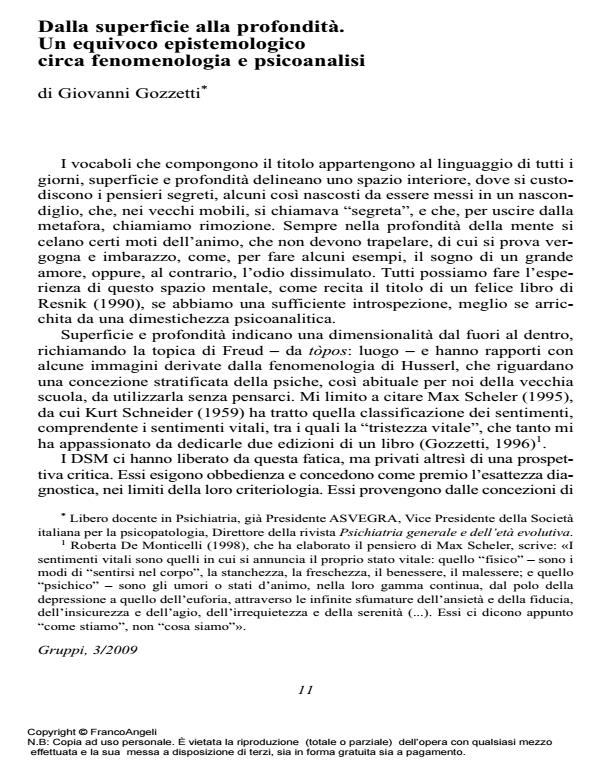Dalla superficie alla profondità. Un equivoco epistemologico circa fenomenologia e psicoanalisi
Journal title GRUPPI
Author/s Giovanni Gozzetti
Publishing Year 2010 Issue 2009/3
Language Italian Pages 8 P. 11-18 File size 291 KB
DOI 10.3280/GRU2009-003002
DOI is like a bar code for intellectual property: to have more infomation
click here
Below, you can see the article first page
If you want to buy this article in PDF format, you can do it, following the instructions to buy download credits

FrancoAngeli is member of Publishers International Linking Association, Inc (PILA), a not-for-profit association which run the CrossRef service enabling links to and from online scholarly content.
From surface to depth. An epistemological misunderstanding concerning phenomenology and psychoanalysis - Surface and depth denote a «from out to in» dimension that is reminiscent of Freud’s subject matter and concerns some ideas coming from Husserl’s Phenomenology about psyche as a stratified apparatus. Diagnostic manuals (DSM) require compliance, awarding correct diagnosis as a prize, but they do this according to their own rules. They are inspired by Carl Hempel’s empirical theories, renouncing validity through a low standard of observer reliability. Yet, if we were to look up our terms - which in good faith we consider neutral - in a good dictionary, we would realize that our patients might be buried under a great many artful words. This is because psychiatric or psychological Knowledge is not only a way of knowing, but also a way of feeling. Thus, we are actually forced to use subjectivity as a path to knowledge. Karl Jaspers started from here to build an understanding phenomenology, where understanding, or Verstehen, refers to an observer’s ability to identify him/herself with the patient and an empathy with his/her internal experiences. Related to this subjective phenomenology, there is also an objective phenomenology which aims at direct access to psychopathological experiences. Objective phenomenological research begins as a sort of "editing" that leads to a reduction; that is, a way of temporarily parenthesizing every given theory, so as to try to achieve a pure description of phenomena. «Parenthesizing and preserving»: the phenomenological method is not to be seen as a way of rejecting psychiatric and psychoanalytic knowledge, but as a practice that allows us to approach the implicit knowledge that does not refute rooted knowledge. We are looking for what - whether consciously or unconsciously - we know, and, with a careful eye to surface description, we can achieve this implicit knowledge simply and precisely. «In scientific work it is better to face what is in front of us, as it offers a glimmer of insight. If we do so carefully, without preconceived assumptions and expectations, and if we are lucky, through unpretentiousness, we might be able to gain insight into great problems, thanks to the link among all things, even the link between a small and big thing» (Freud). This could be aggravating for the adventurous who like inquiring into archaic mental facts; perhaps, however, the surface could raise more questions and hide more secrets than we can imagine, and at the same time it allows us to stay with a patient and to experience the proximity of meeting with him/her.
Keywords: Surface, depth, phenomenology, psychology, psychiatry, psychoanalysis.
Giovanni Gozzetti, Dalla superficie alla profondità. Un equivoco epistemologico circa fenomenologia e psicoanalisi in "GRUPPI" 3/2009, pp 11-18, DOI: 10.3280/GRU2009-003002